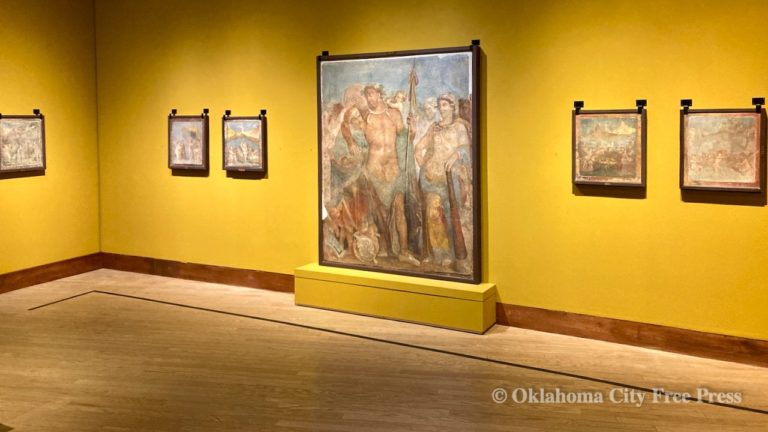
It’s a tale as old as time: Humankind believes itself safe from nature. Nature proves humankind wrong.
Perhaps no more legendary example of this scenario exists than the story of Pompeii, the thriving Roman city famously devastated by the eruption of the towering Mount Vesuvius in 79 AD. Ash and rock rained from the sky, poison gas filled the air, and within a matter of hours, the entire city and its population were reduced to a historical parable and a cautionary tale.
But whereas a disaster on such a scale is a monumental tragedy, the way that the town was destroyed represented a gift to the ages.
Life tragically captured
The ash and debris buried the city but left a large portion of the structures intact. This allowed researchers 1500 years later a remarkably clear and complete picture of life and society within the ancient world, as well as access to the staggering paintings left behind. From the moment that the first excavations began, the attentions of archeologist and art patron alike were drawn to the ornate artworks, murals, and decorations that sat preserved beneath the aftermath of the angry Earth.
Now, nearly 2000 years after the disaster, a massive collection of those pieces, literally carved out of the walls of the city, are on display for all to see at the OKLAHOMA CITY MUSEUM OF ART in an exhibit titled “The Painters of Pompeii.”

Entering the exhibit, the first thing that is made clear to the viewer is that, unlike the vast majority of usual art shows, the focus here is not on the artists that created these pieces. It can’t be, as there is no way to know who could have painted them. Instead, the collection is presented as a walk through history, a look back in time at a culture that lived and worked surrounded at all times by deeply colorful, detailed depictions of the gods and heroes to whom they gave thanks.
Huge!
The second thing that is made clear is just how huge many of the pieces are.
“I think the largest pieces in there are actually several hundred pounds each,” said OKCMOA’s Marketing Director Becky Weintz. “You can see how the team had to support them at the bottom with platforms because they’re so huge and heavy. It all had to be shipped over in a lot of separate shipments.”
Weintz is quick to discuss another important element of the exhibit and its history lesson: the early, immediate demand for the artworks worldwide.
“They’re pieces of the actual structures that they were cutting out to take away and sell,” she explained. “Obviously nothing like that would be allowed now. They’re still working to uncover more of the city and discover more art, but now everything is kept in place where it’s found.”

It’s easy to understand why the Pompeii paintings, all of them created in the ancient “fresco” style of applying the paint directly onto the plaster of the walls rather than a canvas, were so coveted around the world. Historical context aside, they are beautiful to behold.
The depth and range of color on display, the blue skies, porcelain skin, and olive complexions are all shockingly vivid for having weathered two millennia. The myths and legends being shown are cast in such eye-popping relief that, with the exception of a few compellingly-damaged pieces, the subjects of the works remain clear to mythologically-inclined viewers.
And it is the myths and stories being depicted that are arguably more important to the pieces in this collection than the techniques or the painterly decisions on display.
There are a few stirring landscapes or architectural pieces, a couple of still-lifes, and a smattering of costumed actors painted for posterity, but the overwhelming majority of the exhibit consists of mythological scenes and famous tales of the Roman gods and legends. Similarly themed images are grouped together, providing a rare and informative look at the way that the same stories were depicted again and again.
Why similar?
At first, it’s both surprising and almost confusing to see the obvious, near-identical similarities between some of the pieces displayed side-by-side. Two exceptionally large and striking pieces depict the same scene from the life of Achilles, exacted with such identical detail as to include even precise positioning of figures’ hands or weaponry. It is easily clear that the artists are not the same, so why the undeniable similarity?
The texts and descriptions included alongside the artworks fill us in: These huge pieces, beautifully rendered and remarkable even by modern standards, were very likely copied out of pattern books. In Pompeii, it was so commonplace and desirable to fill your house or your workspace with intricate, colorful imagery of the gods and their stories that there were likely how-to books for drawing and painting these gorgeous frescos, with artists copying one another over and over again just to meet the demand.
And then there are pieces whose appeal extends far beyond their imagery into the realm of visible history.
Intense heat
One comparatively small architectural landscape painting stands out from the rest with a wash of deep, fiery orange and red hues. The eye is drawn to the piece’s coloration, so uniquely ominous and almost fearful compared to the surrounding works.
But that was not the piece’s intention. Originally painted in a monochromatic palette of yellow, the work’s colors were burned to orange by the unprecedented heat of the Vesuvius eruption, the volcano’s horrifying, transformative legacy made starkly visible on this piece forever.
Exclusive show
It is by incredible luck and resilience that OKC is actually the one and only stateside appearance of “The Painters of Pompeii.” The collection is on loan from the National Archeological Museum of Naples, Italy, to where it will return after the exhibit’s closing in mid-October.
“It came here from Italy, and then it’s just going right back,” Weintz explained. “There was actually more of a tour planned for the exhibit in the US, but with COVID and Delta rising, all of the other stops decided to cancel, and we decided to go ahead with it.”
Even with heightened caution and safeguards in place for the pandemic, Weintz said that the response has been massive.
“We’ve had a few days during this exhibit that rivaled the busiest days from before COVID,” she said.
Maybe there is something to the fact that Oklahomans know better than many in America the power and intensity of nature. Maybe the pandemic has left a looming, dreadful feeling of so much life being eradicated so unexpectedly. Maybe the oppressive summer heat has many of us feeling the fiery effects of an angry Earth.
Whatever the reason, viewing “The Painters of Pompeii” in person is an experience simultaneously reverent, solemn, and shockingly timely.
Oklahoma City Museum of Art continues hosting “The Painters of Pompeii” now through October 17th. Due to current COVID-cautious guidelines, guests are required to purchase time-specific tickets for the exhibit online at okcmoa.com.
Sustain our journalism by becoming a supporter
Oklahoma City Free Press is dedicated to providing high quality journalism that positively impacts our community. Click this linkto support our mission.
Last Updated September 3, 2023, 8:32 PM by Brett Dickerson – Editor
The post OKCMOA presenting exclusive US look at ‘The Painters of Pompeii’ appeared first on Oklahoma City Free Press.



















